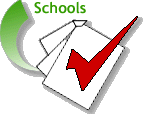Safety Checklist Program for Schools
October 2003
DHHS (NIOSH) Publication Number 2004-101

Appendix B: Using the Safety Checklists to Teach Students about Occupational Safety and Health
Introduction
In career-technical education, students are required to develop competencies in safety and health relevant to their occupational areas. Health and safety training prepares students to understand their rights as specified by law and to take appropriate actions to protect themselves and their co-workers from occupational safety and health hazards. The Safety Checklist Program could be used as one of a number of teaching tools to assist students in attaining competencies related to awareness of safety and health hazards and the federal laws designed to minimize these hazards.
While the manual addresses regulations that may apply to schools, it will acquaint both teachers and students with the types of issues they should be concerned about in the workplace. Knowledge of these issues will be relevant to teachers and students involved in cooperative education programs and relevant in the long term to all students in their future workplace.
Classroom Activities
When using the Safety Checklist Program, teachers can do the following activities in their classroom:
- Select a question or hazard-of-the-week from one of the checklists and spend 5-10 minutes each week discussing it with the class.
- Spend part of a class period over several days or weeks having the students accompanying the teacher on an assessment of the classroom using the checklists.
- Have pairs or groups of students do a hazard assessment using the checklists and report to the class. Pairs or groups should suggest ways to remediate the problems identified. The checklists may need to be simplified or adapted depending on the students’ needs.
- Have students identify one or more classroom hazards of concern to them using the hazard index, or divide hazards among the class members. Each student can select a portion of the checklist pertaining to the particular hazard(s), research or obtain additional information on this hazard and lead the rest of the class through a discussion of the hazard and a tour using the appropriate checklist.
- Create a safety and health committee on a school-wide basis, in your classroom, or with several other related classes to work on improving safety and health in the classroom and school. Hold an election to have student representation on the committee.
- Invite a speaker from a regulatory agency, local business, or professional safety and health organization to discuss safety and health issues relevant to the particular course or program.
- Have students read Appendix C: Suggestions for Facilitating Inspections. Then let them role-play a mock inspection. Students may take the roles of the inspector and the “inspected” or the teacher may play one of the roles. Have the class critique the experience in terms of how both parties worked toward making the event cooperative rather than adversarial. As an alternative, arrange for an actual inspection to occur during class hours to allow students to participate in the event.
Additional Tips and Information
Educators of career-technical programs can use various curricula to accompany the Safety Checklist Program that is available from educational, professional and commercial organizations. One example of this type of curricula is Occupational Health Awareness: Lessons for Vocational Students in Secondary Schools. This teaching module was developed by the New Jersey Department of Health (DOH) and the Environmental and Occupational Health Sciences Institute (EOHSI). It was designed to help students identify occupational safety and health hazards by conducting hazard assessments at their school and at home. They also learn basic principles for hazard control and how to develop emergency response plans. The teaching module uses a wide range of teaching methods, such as role play, problem solving, discussion, and hands-on experience. Teaching materials include lesson plans, slides, a video, handouts, and sample exams.
